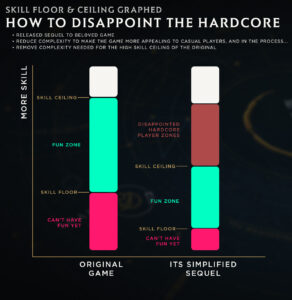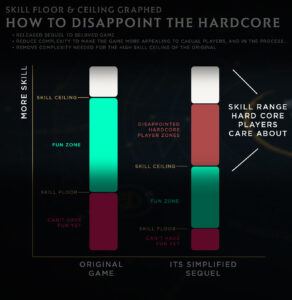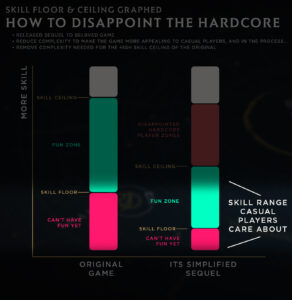High Skill Ceiling & Low Skill Floor
High Skill Ceiling & Low Skill FloorAppealing to a Broad Base
Over the course of IMMORTAL’s development, we’ve been very up-front about our goal of lowering the skill floor for casuals and keeping the high skill ceiling for a hardcore audience. Naturally, one of the most common questions we’ve seen is: “how the heck can you do that?”
The intuition most gamers have is that games can be made easier for the casual audience or fun for the hardcore player, never both, because making the game easier lowers both the skill floor and the skill ceiling. The trick to solving this dilemma only seems obvious in hindsight: nobody ever said that lowering the skill floor forces the skill ceiling to lower by the same amount.
It took us years of testing with both pro-players and casuals brand-new to the genre to realize this, along with a few other key tactics that make achieving our goal not only possible, but reasonable:
- Skill Differentiation is Related but Separate: From what we’ve seen, most people talking about ceilings and floors are mostly worried about skill differentiation: the idea that better players should almost always win. This is a large topic that will need its own article.
- Measure the Magnitude: Changing gameplay can affect the skill floor and skill ceiling by different amounts. Ideally, change the skill ceiling by a little and the skill floor by a lot.
- A Ceiling Beyond Human Potential: There are some games that have so much potential for skill, the “true” skill ceiling is far beyond what is humanly possible – CS:GO, DOTA2, and StarCraft are brilliant examples of this. In the case of these games, lowering the skill ceiling is practically meaningless if the new skill ceiling is still beyond human potential.
- Reward a Diversity of Skills: The skill ceiling is a result of different skills that players are able to master: a player can improve their fine army control, broad tactics, or economic output, and all help them win more matches.
- By rewarding many different kinds of skills, players are able to have fun and win games by doing what they enjoy most. This also helps define different playstyles and identities, something that esports benefits greatly from (Remember Flash’s insane marine micro in Brood War?)!
- This tactic also means that we can raise the skill ceiling by providing more avenues for players to improve through – if you feel like you’re as good as you’ll get at game knowledge, you can always improve on your army control to keep getting better.
The Pain
We all know where this topic comes up the most: a sequel comes out, but fails to deliver on the magic of the original because the gameplay was developed to be so simple. The below graphic illustrates what drives the frustration behind this:

So that we’re all on the same page…
- The skill ceiling is the limit of how good you can be at a game. For hardcore audiences and esports titles, the skill ceiling needs to be beyond human potential.
- The skill floor is how much work a player must put into a game before they begin having fun. You may have heard this referred to as the “barrier to entry,” and most games benefit from keeping this as low as possible.
- The fun zone is the range of skill where you’re good enough to have fun playing the game, and where improvement is both possible and results in better outcomes: more matches won, more points scored, and so on.
It becomes easy to understand the problem developers keep running into by narrowing our focus to the hardcore and casual perspectives.

In the original game, hardcore players have an enormous fun zone, and are constantly able to improve. Unfortunately, the sequel only has a tiny slice of its fun zone in the range that matters to hardcore folks. Some of these players will still enjoy it, but many of them won’t.
Then you have the flipside:

The sequel has opened up a ton of its fun zone to casual skill ranges. This means more casual players can have fun, the player base grows, sales go up… but at the cost of leaving hardcore players out to dry. These hardcore players, who have poured hundreds of hours into the original and built a whole network of friends around it, suddenly have it all ripped away. If history is any guide, it’s probably not coming back.
This pattern, a tale as old as time, creates a level of resentment and hostility towards casuals and the developers who cater to them. The good news is that it doesn’t have to be this way.
From what we’ve seen, the concern around a “low” skill ceiling boils down to a desire to constantly improve. Hardcore players want achieving mastery to be an endless journey, and every step taken, every challenge overcome, should feel satisfying. This creates the high-skill “fun zone” shown above.
Many beloved games achieved these criteria through complex mechanics that tend to overwhelm new players—and those mechanics are often the first on the chopping block when trying to open up the game to a wider audience. Obviously, this isn’t ideal for the hardcore audience.
Picking Better Targets
Luckily, there are other options here to lower a skill floor that don’t harm the skill ceiling. Some examples:
- Opt-In Complexity: Players can dive into the game’s complexity to get better results, but don’t need to in order to have fun.
- Simplified Modes: Create game modes with less complexity that players can use to learn how to play (thanks to our Kickstarter backers, we’re able to do this through Wave Wars, removing player control of units and focusing the game entirely around decision-making. The slower pace allows players to learn more about the faction and units. Learn more about Wave Wars at our Kickstarter!)
- Cutting the fat: In games with a skill ceiling beyond human potential, some mechanics can be removed entirely, and the ceiling still lies beyond human potential.
- Buffing the Ceiling: Introducing new gameplay elements to master, especially ones that don’t raise the skill floor. This helps with both maintaining an impossible skill ceiling and adding more skill diversity.
IMMORTAL has done all of the above to solve the skill floor/ceiling dilemma, and our next article will dig into some of the specifics we’re bringing to the table to achieve that.
We touch on similar subjects in our Strategy Redux article.
Co-written by:
- Colter Hochstetler, Director of Game
- Donavon Bailey, Designer
- Tom Labonte, UX Lead



